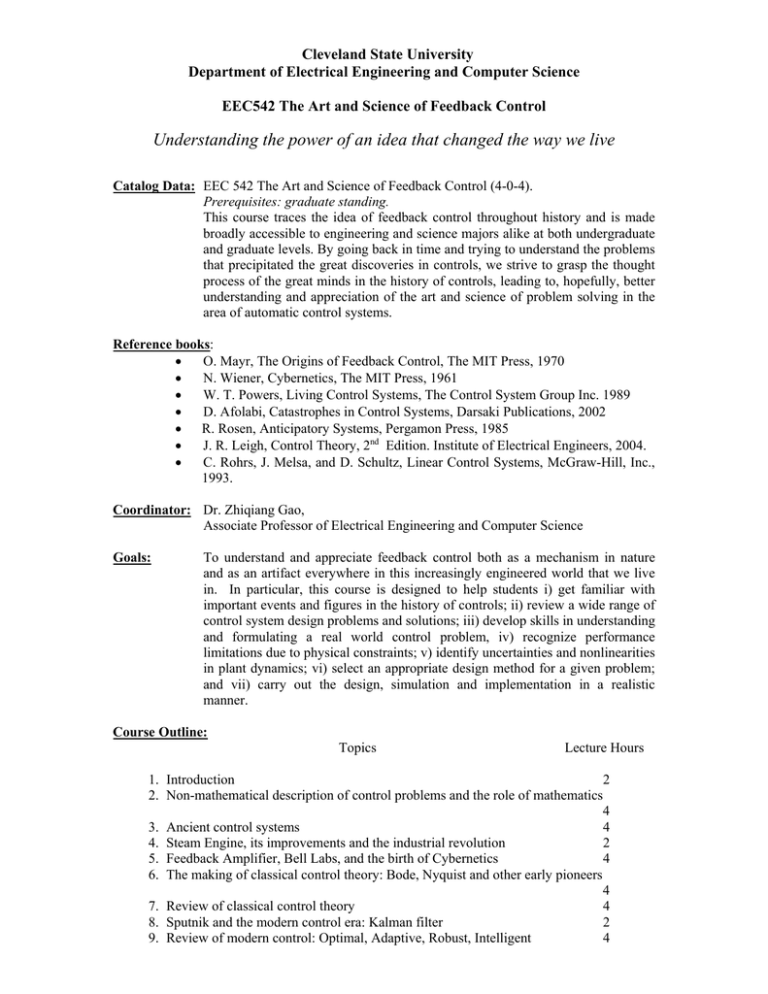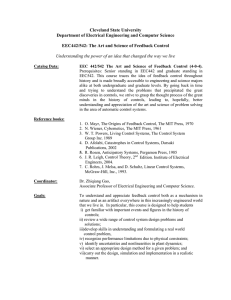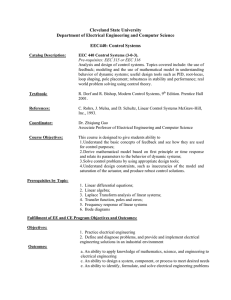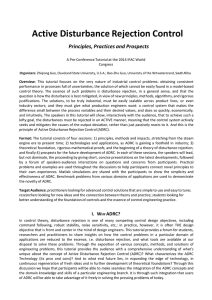Cleveland State University Department of Electrical Engineering and Computer Science
advertisement

Cleveland State University Department of Electrical Engineering and Computer Science EEC542 The Art and Science of Feedback Control Understanding the power of an idea that changed the way we live Catalog Data: EEC 542 The Art and Science of Feedback Control (4-0-4). Prerequisites: graduate standing. This course traces the idea of feedback control throughout history and is made broadly accessible to engineering and science majors alike at both undergraduate and graduate levels. By going back in time and trying to understand the problems that precipitated the great discoveries in controls, we strive to grasp the thought process of the great minds in the history of controls, leading to, hopefully, better understanding and appreciation of the art and science of problem solving in the area of automatic control systems. Reference books: O. Mayr, The Origins of Feedback Control, The MIT Press, 1970 N. Wiener, Cybernetics, The MIT Press, 1961 W. T. Powers, Living Control Systems, The Control System Group Inc. 1989 D. Afolabi, Catastrophes in Control Systems, Darsaki Publications, 2002 R. Rosen, Anticipatory Systems, Pergamon Press, 1985 J. R. Leigh, Control Theory, 2nd Edition. Institute of Electrical Engineers, 2004. C. Rohrs, J. Melsa, and D. Schultz, Linear Control Systems, McGraw-Hill, Inc., 1993. Coordinator: Dr. Zhiqiang Gao, Associate Professor of Electrical Engineering and Computer Science Goals: To understand and appreciate feedback control both as a mechanism in nature and as an artifact everywhere in this increasingly engineered world that we live in. In particular, this course is designed to help students i) get familiar with important events and figures in the history of controls; ii) review a wide range of control system design problems and solutions; iii) develop skills in understanding and formulating a real world control problem, iv) recognize performance limitations due to physical constraints; v) identify uncertainties and nonlinearities in plant dynamics; vi) select an appropriate design method for a given problem; and vii) carry out the design, simulation and implementation in a realistic manner. Course Outline: Topics Lecture Hours 1. Introduction 2 2. Non-mathematical description of control problems and the role of mathematics 4 3. Ancient control systems 4 4. Steam Engine, its improvements and the industrial revolution 2 5. Feedback Amplifier, Bell Labs, and the birth of Cybernetics 4 6. The making of classical control theory: Bode, Nyquist and other early pioneers 4 7. Review of classical control theory 4 8. Sputnik and the modern control era: Kalman filter 2 9. Review of modern control: Optimal, Adaptive, Robust, Intelligent 4 10. Mathematization of control engineering: not that there is anything wrong with it 4 11. An alternative problem formulation: ataraxia-freedom from disturbance 2 12. Poncelet’s Principle: disturbance rejection without feedback 2 13. Schipanov and invariance principle 2 14. Han and Active Disturbance Rejection Control 4 15. Recent developments in advanced industrial control 2 16. Case Studies: formulation and solutions of real world control problems 4 17. Presentations 8 18. Exam 2 Total 60 Design Projects:Students are required to complete two design projects; carrying out a research project by solving a particular control problem of their choice, write a term paper and make a presentation. Non-Design Projects: Students generally complete at least two non-design projects on history of great ideas in controls and on novel applications of control theory in non-engineering fields. Computer Usage: Some projects may require the use of Matlab/Simulink. Teaching and Learning Methods: A problem oriented teaching method will be employed to promote active learning on the part of students. Instead of starting with the end results of many years of research and practice, we’ll begin with the problems that puzzled the pioneers of our fields. We’ll study the nature of the problems and the train of thoughts and methodologies that led to the success of the past investigations. It is in this sense that we gain a historical perspective and some understanding of how those great minds work, helping us, hopefully, to be a more active learner and a creative thinker. About Feedback Control: Feedback control is an idea that has been discovered and rediscovered throughout human history. Today, it permeates all engineering branches, natural sciences and social sciences. Understanding the essence of this idea and its manifestations in various feedback systems, natural or artificial, allows us to gain deeper insight on how these systems work and, more importantly, to make them work better. Prepared by Dr. Zhiqiang Gao Revised by Dr. Zhiqiang Gao Date: Sept. 20, 20005 Date: Nov. 3, 2008







